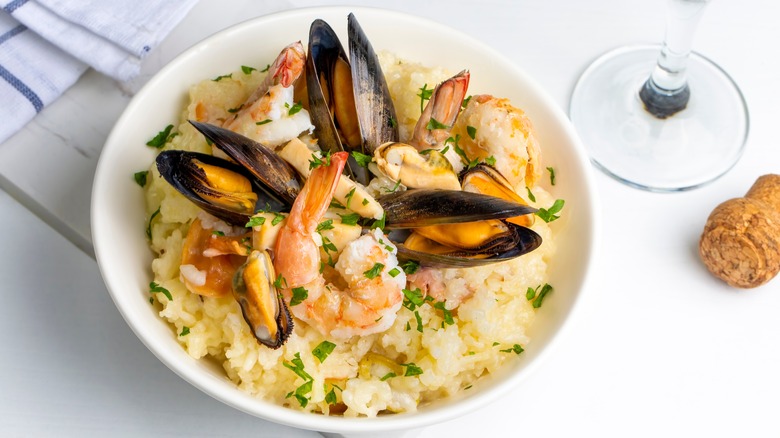Is Risotto Considered A Rice Or Pasta Dish?
If you've ever watched cooking shows like Hell's Kitchen or MasterChef, you likely know risotto is one recipe that strikes fear in the hearts of many chefs. The creamy Italian dish, which resembles porridge, is known for being fickle. Risotto needs a lot of stirring — but too much will ruin the texture. The rice must be toasted — but too much toasting will keep the grains from releasing their starch. You can use oil to toast the rice — but you shouldn't use it to finish the dish because that could keep the rice from coagulating the way it's supposed to. And these are just a few of the mistakes you can make when making risotto.
If you're not a pro chef, you might have even more basic questions about risotto — like, for instance, is risotto considered a rice dish or a pasta dish? If you impulsively think of risotto as a pasta dish, it's little wonder why — it's Italian, it's starchy, and it tends to use a lot of the same flavors and ingredients that are common in pasta dishes, such as parmesan, olive oil, and basil.
However, the difference between pasta and risotto is the type of starch used: Risotto is made from short-grain rice; whereas in almost all cases, pasta is made from ground wheat flour mixed with water, and sometimes eggs.
Butter, rice, and everything nice
You've probably seen pictures or videos of pasta being made, where the dough is made from flour and water, and sometimes other ingredients such as eggs or oils. The stretchy dough then is shaped by hand or fed through a pasta machine to form it into particular shapes, from long, flat strings for fettuccine, to bowties pinched in the middle for farfalle.
No such process applies to risotto, because the starch used is rice, not flour. Although rice can be ground into flour to make things like Asian-style noodles or dumpling wrappers, risotto uses rice in its natural grain form. Certain types of rice work best for risotto, namely arborio, and carnaroli, because they're particularly starchy and can soak up a lot of moisture, meaning the grains become soft, but not mushy.
Risotto generally also includes butter, white wine, stock, alliums, and herbs. You can also make risotto with mushrooms, veggies, or seafood. After toasting the rice and sauteéing the aromatics, the stock is added to the rice a little at a time, with constant stirring to gradually incorporate it. The result is a silky, creamy, porridge-like mixture that's soft yet toothsome, and packed with a symphony of comforting flavors.
Know your rice grains from your pasta pearls
Pasta is made from wheat, which contains gluten. But risotto is made with rice, a completely different and naturally gluten-free plant. Since risotto is made from rice, it can be made gluten-free, which is good to know if you or someone you're cooking for has any kind of gluten intolerance. Something you may want to note is that stock can sometimes contain wheat proteins, so be sure to check ingredient lists if you're buying premade.
Another note: Be sure you use actual rice, not orzo. Although orzo is also Italian and comes in the shape of little grains, orzo is a kind of pasta. It's not gluten-free, and it won't clump the way rice will. You can make a risotto-like dish with orzo, but orzo and rice are not the same and need to be prepared differently. They are similar enough that even the pro chefs competing on Hell's Kitchen have mistaken one for the other. After all, both are starchy and delicious. But only risotto — which comes from riso, the Italian word for rice — can deliver a silky-smooth, richly creamy bite that's worth the sore muscles from all that stirring.


